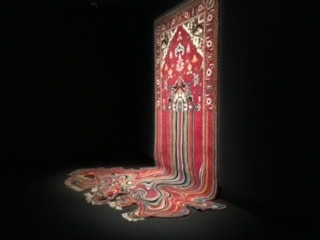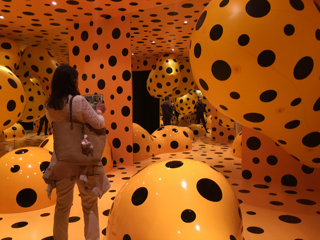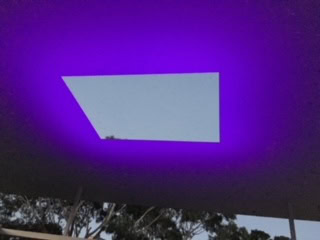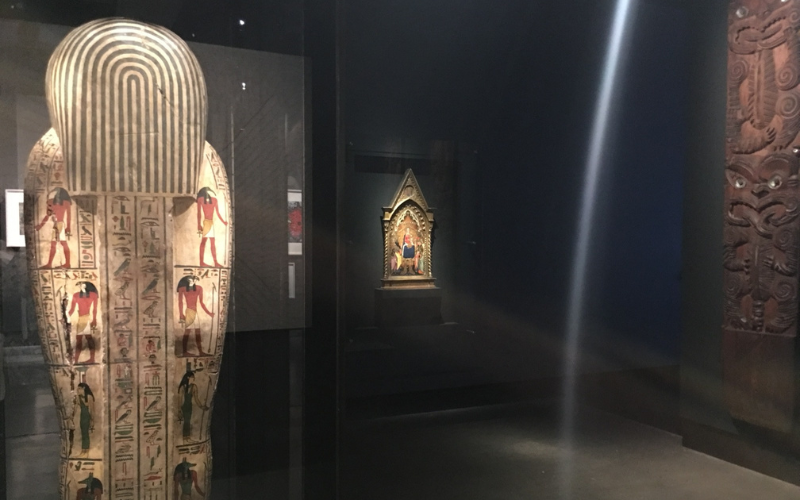MONA: The Museum of Old and New Art in Hobart, Tasmania–A World-Class Art Experience by Guest Poster Linda Moore
Guest poster and novelist Linda Moore takes artsy travelers on a journey down under to remote Tasmania to experience the Museum of Old and New Art (MONA). Find out more about Linda Moore and her debut novel, Attribution. Author Joshua Mohr (Model Citizen) calls Attribution a “high-concept arthouse puzzle.” Sounds intriguing!
Written by Linda Moore for Artsy Traveler
Arriving at MONA
If possible, arrange to arrive at the Museum of Old and New Art (MONA) by water. The 25-minute ferry ride from Hobart in Tasmania brings into dramatic focus a clifftop complex that rivals any of the major museums of the world.
To reach the museum entrance from the ferry dock, you’ll need to climb one hundred steps. If you wish to avoid the climb, you can travel to the museum by car from Hobart, a 20-minute drive away.
Of course, no matter how you arrive at MONA, you’ll have traveled many hours to remote Tasmania, an island off the coast of Australia.
Is the long journey worth it? Absolutely! Despite its isolation, MONA has become a world-renowned art destination—and a must-visit for the artsy traveler.

What is MONA?
The creation of gambler-turned-art collector David Walsh, MONA will appeal to art lovers interested in experiencing a stunning collection of old and new art and impressive architecture.
Walsh, a controversial figure with a large bank account, built his museum for his own amusement and to provide a landing place for art that interests him. Almost everything about MONA is different from other museums. Check out the MONA website and read the content. Even ordinary information such as how to get to the museum is presented with a quirky twist.
MONA’s Collection
The essence of MONA is not its eccentricities, but its collection, and Walsh does not disappoint. MONA displays pieces from a full range of the history of art. The eclectic installation includes art from ancient Egypt, the European Renaissance, and Pacific Islanders.
You’ll find an Egyptian sarcophagus and Asian scrolls along with 20th-century works such as Georgia O’Keefe’s flowers and provocative works such as Matthew Barney’s genitalia.
Why I Loved MONA
MONA draws me and others who travel the world to see art because we want to discover artists we don’t know about, the ones whose original ideas are not derivative of the major art scenes in New York or Berlin. Similar to traveling to the Venice Biennale or Documenta, a journey to remote MONA exposes you to new art and new ideas.
For example, Azerbaijani artist Faig Ahmed’s woven fiber pieces use an ancient art form in a contemporary way. His work appeared in the Venice Biennale and later was added to a show at MoMA in New York. But how many of us know about art in Azerbaijan?

Walsh’s collection spans the globe and his curators are on the hunt for fresh ideas from artists whose works may never be seen by curators from big international institutions.
MONA’s Installations
The site-specific installations at MONA are the showstoppers. Examples include Yayoi Kusama’s room with dizzy dots and the two-story waterfall by German artist Julius Popp that spills text generated by 128 computer-controlled nozzles streaming words from real Google searches.

Generous budgets and plenty of space provide artists with creative opportunities that may not be possible in large city museums. For example, an $18 million tunnel completed in 2019 houses works by Chinese artist Ai Weiwei, who spent time in prison for his art, and The Divine Comedy, a light installation of hell, purgatory, and paradise by one of my favorites, Chilean-born artist Alfredo Jaar. Here’s a link to The Divine Comedy featured in an article in The Guardian.
When to Visit
Schedule at least a day-long visit so you can view the James Turrell light pieces like Pharos (named after the lighthouse in Alexandria) inside a tunnel and then remain until sunset to sit outside under Turrell’s Amarna project that glows and changes as the sunlight in the Southern hemisphere disappears. Stunning.

Shore lights twinkle as you travel back to Hobart on the night ferry and the peaceful channel creates space to ponder the impressive art experiences you’ve enjoyed at MONA.
Practical Information
MONA is only open Friday to Sunday, so temporary exhibitions are displayed for five to six months. You must purchase your ticket in advance and ensure you have reservations for everything you want to see.
Read about Linda Moore on the Artsy Traveler Guest Posters page. Here are some other contributions from guest posters to help you with your travel planning:
- Hidden Gem: Santa Maria del Popolo in Rome by Andie Easton
- Three Tips Every Writing Adventurer Needs to Buy The Damn Hat by Tina Overbury
- The Joys of Exploring the World with Small Group Tours by Julie H. Ferguson
Have you traveled to MONA? Share your suggestions and experience in the comments below.
